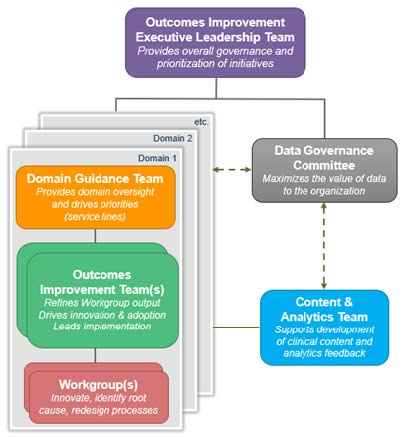Consistent Improvement Methodology Accelerates Healthcare Outcomes

- $15.5 million in savings, including:
- $8.2 million in sepsis cost savings.
- 34.5 percent relative reduction in mortality for patients with sepsis prior to admission, saving 124 lives.
- $3.2 million in orthopedic service line savings.
- $1 million in LOS reductions and $1 million in increased revenue from a newly designed outpatient total joint arthroplasty program.
- $2.32 million integrated primary care savings.
For healthcare organizations, the ability to analyze problems and implement timely, effective improvements is necessary to maintain a competitive advantage. An important component of successful, permanent improvement is using a consistent, systematic approach to introduce and implement change within an organization.
Community Health Network (CHNw) had invested in training caregivers on several improvement science models. However, improvement efforts at CHNw were often siloed and not widely spread across the organization, contributing to a lack of sustainability. By developing a new strategy focused on uniform adoption, education, and ongoing oversight, the organization aimed to change the way it approached all organizational improvement efforts going forward. CHNw has experienced impressive early adoption of its systematic improvement approach, and the new structures are already bringing value to the organization.
CONSISTENCY IS KEY TO SUSTAINABLE IMPROVEMENTS
The ability of healthcare organizations to change, adapt, and evolve is a competitive advantage.1 More than half of health IT leaders report that it is difficult to consider new technologies that require substantial changes across disciplines, even when the technology has the potential to improve patient care and satisfaction.2 Successful and sustained improvement requires a consistent approach to the introduction and implementation of change within an organization.3 Single improvement approaches are not meant to replace change methodologies or tools used by organizations, but rather to provide a framework for analytics, organizational collaboration, and feedback to remove barriers and accelerate outcomes.4
CHNw is a non-profit healthcare organization, serving central Indiana. It is consistently ranked among the nation’s most integrated healthcare systems. Based in Indianapolis, CHNw serves more than 539,000 patients and employs over 15,000 caregivers, providing access to exceptional healthcare services, where and when patients need them—in hospitals, health pavilions, and doctor’s offices, as well as workplaces, schools, and homes. CHNw values patients first and is committed to providing patient-centered care and outstanding service, delivered with respect and compassion.
SILOED IMPROVEMENT EFFORTS HINDER WIDESPREAD CHANGE
Previously, CHNw had invested in training caregivers on several improvement science models, such as lean production, Six Sigma, and change acceleration strategies. However, improvement efforts were often siloed and not widely spread across the organization. Without a common improvement approach, the organization had many well-intended projects, but a lack of governance and inefficient resource utilization reduced the potential effectiveness of improvement efforts.
Because CHNw lacked actionable data, it was difficult for the organization to identify and prioritize improvement efforts. To facilitate sustainable improvements, CHNw needed to change and better organize its improvement efforts to ensure widespread adoption across the organization.
NEW STRATEGY ENABLES SYSTEMATIC IMPROVEMENT APPROACH
CHNw leadership established a vision for quality, aiming to deliver an exceptional experience to every life it touches. The organization describes quality as defined by its individual patients, based upon outcomes, experience, cost, and the appropriateness of care. CHNw partnered with Health Catalyst, implementing improvement functions in three systems to achieve systematic, organization-wide change.
- Best practice system: The tools, processes, and evidence that defines what the organization should be doing.
- Analytics and feedback loop: Using the Health Catalyst® Data Operating System (DOS™) platform, CHNw is able to analyze available data to assess priorities and monitor progress toward goals.
- Adoption: The governance structures necessary to enable and sustain change.
With this support, CHNw was able to adopt a consistent, systematic improvement methodology across the organization. This consistency in problem-solving and improvement provides a common language and sequence of steps for reaching goals, effectively establishing best practices across CHNw.
The improvement approach CHNw selected is compatible with multiple improvement methodologies, including Six Sigma, PDCA, DMAIC, and design thinking. It was important that the strategy be agile and adaptive, allowing teams to navigate improvements in an iterative fashion by moving quickly through some phases, or revisiting earlier steps as needed to ensure a positive outcome.
With the improvement approach in hand, leadership established a governance structure and commissioned permanent improvement teams to help achieve key organizational priorities and goals. CHNw’s governance structure integrates several important principles, including:
- Stakeholder engagement: Stakeholder engagement starts at the very top of the organization. CHNw’s executive leaders engaged around a common vision for quality.
- Shared understanding: There is a common understanding of organizational needs, capabilities, and readiness.
- Alignment: In addition to adopting a consistent improvement methodology, CHNw aligns incentives, and works to balance polarities within the organization.
- Focus: The organization practices disciplined decision-making to prioritize, fund, organize, and sustain initiatives.
The permanent improvement teams are fully resourced, and the initiatives they spearhead are prioritized above other improvement efforts due to their alignment to strategic objectives. The permanent improvement teams also support ongoing efforts with representation from the necessary organizational functions, including outcome performance managers, financial analysts, clinician champions, and executive sponsors, to ensure organizational changes are widely adopted (see Figure 1).

Data analysts and CHNw outcomes and performance managers facilitate data-driven improvement, leveraging data from Health Catalyst Data Operating System (DOS™) platform to generate new insights. Clinical leadership views data and analytics as strategic asset, helping to drive adoption and accelerate improvements. When facing challenging organizational problems, CHNw asks and answers seven critical questions:
- Do we understand the problem?
- Do we know where we want to be?
- Do we know the cause?
- Do we know what to change?
- Have we applied and measured the change?
- Did the change result in improvement?
- Are we sustaining the gains?
Coordinated training was provided for leaders across the system through in-person meetings and written materials. Leaders are encouraged to use the framework for improvement innovations within their service lines. Once prioritized and selected, projects are deployed to the permanent improvement teams to begin the improvement process.
This consistent, systematic, and widespread improvement approach provides CHNw leaders with a comprehensive repository of projects across the network, enabling status reports and ongoing resource allocation so that all future initiatives have a great chance for success.
RESULTS
The consistent, systematic improvement approach has begun to accelerate improvement at CHNw. The health system has experienced impressive early adoption of its improvement approach, and the new structures are already bringing value to the organization. In just two years, CHNw has:
- Trained more than 800 leaders in its new improvement approach.
- Resourced eight permanent improvement teams.
- Thirty-five active improvement projects in process.
The improvement teams are delivering impressive results. For example:
- $15.5 million in savings, including:
- $8.2 million in sepsis cost savings, the result of improved recognition, diagnosis, and treatment of sepsis, and reductions in average variable cost per case and average length of stay (ALOS).
- 34.5 percent relative reduction in mortality for patients with sepsis prior to admission, saving 124 lives.
- 1,047 emergency department (ED) bed days saved, the result of decrease ED ALOS for patients with sepsis prior to admission, and 147 inpatient bed days saved, the result of a decreased inpatient ALOS.
- $3.2 million orthopedic service line savings.
- $1 million in additional revenue from a newly designed outpatient total joint arthroplasty program.
- $1 million in LOS reductions.
- $2.32 million integrated primary care savings.
- $1 million in savings for Geriatric Evaluation Management (GEM) patients.
- 407 lives impacted. Patients receiving care from the GEM have a mortality rate that is 1.45 percent less than that of non-GEM patients.
- 8.8 percent relative increase in overall screening rate for colorectal cancer—74,889 patients were screened for colorectal cancer between January and September of 2018—7,221 more patients than the number of patients screened in all of 2017.
- $1 million in savings for Geriatric Evaluation Management (GEM) patients.
- $986,000 cardiovascular service line savings.
- $161,000 in additional revenue through improved management of atrial fibrillation.
- $541,000 in readmission cost avoidance, the result of a 21 percent relative reduction in heart failure 30-day readmission rates.
- $660,000 maternal child service line savings.
- $403,000 savings by reducing the variable cost per case across the CHNw system in just one year by implementing a standard medication-assisted treatment program for pregnant women with opioid misuse during pregnancy.
- 64.3 percent relative increase in long-acting reversible contraception.
- 39 percent relative reduction in the number of episiotomies performed, with 127 episiotomies avoided.
- $8.2 million in sepsis cost savings, the result of improved recognition, diagnosis, and treatment of sepsis, and reductions in average variable cost per case and average length of stay (ALOS).
“Rather than rushing to a solution, leaders are now applying the improvement framework to both small and large problems, pausing to be certain we know the problem we need to solve, and focusing their improvement efforts on the processes associated with the problem.”
– Patrick McGill, MD
EVP, Chief Analytics Officer
WHAT’S NEXT
Having established a consistent improvement approach supported with data and analytics, CHNw intends to further expand its data literacy and expand its use of analytics to drive improvement, and plans to further reduce clinical variation, improving the quality of care delivered to patients.
REFERENCES
- Al-Abri R. (2007). Managing change in healthcare. Oman Medical Journal, 22(3), 9-10.
- Spok. (n.d.). Healthcare technologists are adapting to survive.
- The Health Foundation. (2016). Quality improvement made simple – What everyone should know about health care quality improvement.
- Institute for Healthcare Improvement. (n.d.). Science of improvement: How to improve.
This website stores data such as cookies to enable essential site functionality, as well as marketing, personalization, and analytics. By remaining on this website you indicate your consent. For more information please visit our Privacy Policy.